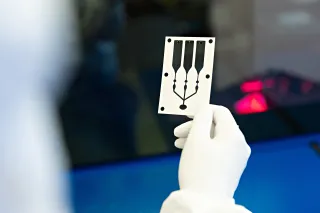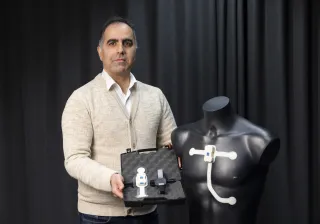Significant innovations and new technologies are born every day. We read about scientific breakthroughs in the news and buy new technologies to use at home. But how do we know whose promises we can trust and how do we tell the difference between someone talking a big game and actual verified fact? Metrology, or the science of measurement, supports innovation by ensuring the quality and comparability of measurements, regardless of time and place.
Research scientists are discovering technologies that promise to change the world. Air quality can be improved with furniture coatings that remove harmful chemicals. The fight against climate change can be advanced with more accurate modelling. Food can be grown in vertical farms – perhaps some day on Mars. Sensors that utilise artificial intelligence can alert people immediately when an industrial process is disrupted in some way. Renewable energy can be stored and then used with ever smaller losses in efficiency.
In an environment inundated with bad news and reasons to fret, it is comforting to read about innovation and solutions to global problems. But how do we ensure that inventions and technologies really work, are safe to use and do what they promise to do?
If a new breakthrough is based on nothing but grand promises without proof of functionality, the result may not only disappoint but also cause real damage to people, the environment and businesses.
Metrology challenges innovations and innovations challenge metrology
We don’t want to fool customers with empty sales pitches about air-purifying furniture, over-analysed satellite images or heat pumps that may or may not be efficient. Instead, we prove the effectiveness and verify the promises of these breakthrough technologies with measurements that can be shown to be established and to conform to the International System of Units (SI).
There are two key concepts in metrology: metrological traceability and measurement uncertainty. Metrological traceability means that a measurement can be related to an SI-reference through an unbroken chain of comparisons, also known as calibrations. For example, after harmful gasses have been removed from inside air, the device used to measure their presence can be calibrated with a gas mixture that has a precisely known composition. The desired gas contents can be produced by mixing a known amount of it with air. The amount of gas released can be determined by weighing the container and measuring the release time. When the scales that are used have also been calibrated with kilogram weights that can themselves be traced to SI-standard weight calibrations, our traceability chain is complete.
Measurement uncertainty, in turn, describes the possible variance in measurement results from the true value. It describes the degree of (un)certainty in measurements. Therefore, our scales can return a result that differs from the true gas content of the air because, for example, the calibration gas mixture can only be produced with a certain degree of precision due to the limitations of the tools used to produce it or because the ventilation of the space has an adverse effect on the reliability of the measurements. Every individual reference – the links of our traceability chain – has an adverse effect on certainty.
Comparability of measurements is the cornerstone of the metrology system. By comparing your measurements with other metrologically traceable measurements, you can determine your degree of certainty. Measurement results should be within the estimated margin of uncertainty. If, for example, the amount of a harmful gas in the air is being measured in the same space by means based on gas chromatography or optical spectroscopy, results should not vary by more than the margin of uncertainty. If they do, either the method of measurement itself is at fault or the possible degree of uncertainty has been underestimated. Phenomena are often complex. In addition to the measured phenomena itself, measurement devices and environments can also cause surprising sources of uncertainty.
In short, metrology reveals the true beauty or cold truth of innovations: whether or not they actually live up to their promises. Can we trust the results – be the question the effectiveness of a formaldehyde removal method, the quality of a satellite picture, the optimal growing environment of a plant, the decision made by a sensor or the true efficiency of a heat pump? Are the measurement results genuinely comparable to those achieved with other similar devices and methods?
Measurement standards for future innovations
While the basic units of measurement are unchanging, the field of metrology is in a constant state of flux. Metrologists must stay up to date in order to serve the needs of cutting-edge technological innovation. The traceability they emphasise must be brought over from the SI standard to new spearhead technologies. Measurement uncertainty must be estimated so that the capabilities of new technologies can be established. It is important that metrology and metrologists have more to say than simply stating: “That measurement is wrong.” Metrology needs to explain where improvements need to be made and what matters need to be concentrated on in innovation and technological development.
Developing measurement standards and improving the traceability of measurements for purposes that are still impossible to imagine today will support the innovations of tomorrow, be it measuring small amounts of formaldehyde, distinguishing the natural from the human-made in measurements of global temperatures, speeding up the growth of plants, evaluating artificial intelligence through metrology or measuring the true efficiency of that heat pump or of something we can’t even dream of yet!




